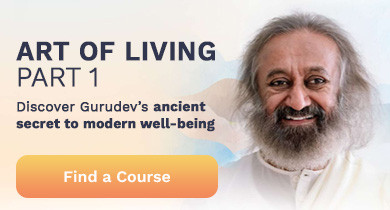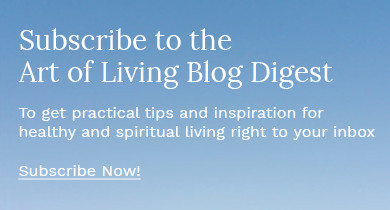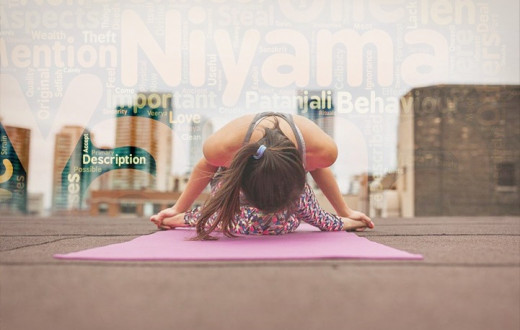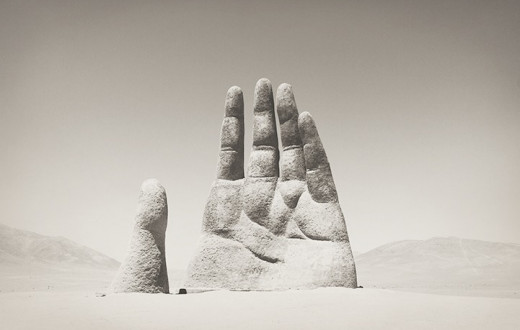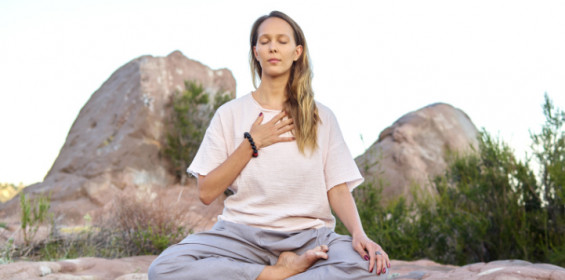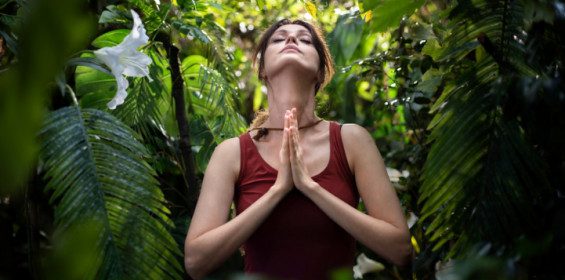By Sejal Shah
Give your body, mind, and spirit a beautiful gift of Padma Sadhana- a profound yet quick yoga, breathing, and meditation flow. Learn with this video!
Are you looking for a holistic and invigorating yoga sequence to give a wonderful start to your day?
Are you a very busy person with too much going on in life, yet looking for something that can take care of your body and mind efficiently and effectively?
Well, Padma Sadhana can be your solution.
What is Padma Sadhana?
Padma means lotus and sadhana means disciplined spiritual practice or effort.
Lotus is a symbol of purity and knowledge or enlightenment. Usually when one thinks of a lotus, what comes to mind? A fully blossomed flower, where each beautiful petal is opening up to the sky. But where does lotus grow? In dirty and muddy water. Yet, the lotus remains unstained and untouched by the mud and it radiates so much beauty, purity, and peace. Imagine if we could also be like the lotus flower - untouched by day-to-day events and blossom with love and joy. Padma Sadhana is a practice that could make such blossoming possible. Designed by Gurudev Sri Sri Ravi Shankar, this beautiful yoga practice comprises a simple sequence of 14 yoga postures, one pranayama (breathing technique), and meditation. Thus it is a complete and wholesome practice.
Unlock your potential with Padma Sadhana
Gurudev says doing Padma Sadhana gives you access to your inner strength. When practiced daily, this 45-minute sequence of yoga poses can lead to a calmer mind, healthier body, and more peace. This set of graceful yoga asanas (postures) helps prepare the body and mind for deeper meditation. One of the key tips is to stay relaxed throughout the practice. Doing Padma Sadhana before Sudarshan Kriya enhances your experience so that you remain uplifted throughout the day, untouched by the mud around you.
‘Padma’ means lotus and ‘Sadhana’ is your effort. This practice should therefore be as effortless and light as a lotus. Sadhana is the gentle nudge to get on to the mat and Padma is the unfurling of your potential, layer by layer. Together, Padma Sadhana can help you blossom from within through the practice of yoga postures.
What does the Padma Sadhana sequence look like?
A very gentle yet so deep, Padma Sadhana, is a very meditative practice. The entire Padma Sadhana sequence is 45-minute long, which includes 15 minutes of yoga postures, 5 minutes of Nadi Shodhan pranayama, 20 minutes of meditation (guided meditation or Sahaj Samadhi meditation), again followed by 5 minutes of Nadi Shodhan pranayama. The yoga postures in Padma Sadhana are held for a longer time (about 30-60 seconds each) and flow into each other, with each yoga pose complementing the preceding one. When done correctly, Padma Sadhana stretches the body and prepares the mind for meditation. In fact, each yoga posture in the Padma Sadhana sequence becomes a meditative experience by itself.
What asanas (yoga poses) are included in the Padma Sadhana?
There are 15 asanas that gently flow into each other. Though it may look like a series of 15 asanas, it is done in such a way that it feels like one single asana. Asanas are followed by pranayama and meditation.
Body or Back Rotation
Ardha Shalabhasana (Half Locust pose)
Shalabhasana (Locust pose)
Bhujangasana (Cobra pose)
Viparita Shalabhasana ( Superman pose)
Dhanurasana (Bow pose)
Naukasana (Boat pose)
Ardha Pawanmuktasana (Wind Relieving pose)
Purna Pawanmuktasana (Wind Relieving pose)
Sarvangasana (Shoulderstand)
Natarajasana (Dancing Shiva pose)
Ardha Matsyendrasana (Spinal twist)
Parvatasana (Mountain pose)
You can also practice with this beautiful video:
5 tips to deepen your Padma Sadhana
Just as it is important to know how to do Padma Sadhana (move the body into yoga postures). It is also important to practice Padma Sadhana with the right attitude, the right feeling.
Follow the five tips and make your Padma Sadhana experience blissful, deep, and meditative.
1) Keep the body stable. When you get into any posture for Padma Sadhana, ensure that you are not very unsteady or uncomfortable. Meditation happens when the body is at ease. The Patanjali Yoga Sutra, Sthira Sukham Asanam, gives prime importance to both stability and comfort while doing your asanas (sthira=stable; sukham=comfort).
If your body is shaky in a particular posture, it means you are overdoing it. Find a position that is stable and comfortable for you.
2) Be mindful and grateful. Once you have attained stability in the yoga posture, move on to the next level – awareness.
Integrate your body and breath with breath being the connection between the two. Keep your attention inward with gentle awareness of your breathing, sensations in the body, and the state of your mind as you flow in, holding or flow out of the posture.
You may be totally aware of the movement but you may just be doing it mechanically like a robot. Instead do each posture with a sense of honor to the body, mind, and very prana - life within you.
3) Let the yoga poses flow gracefully like a dance. The whole beauty of Padma Sadhana lies in the graceful manner in which it is carried out. With awareness, you can bring grace to your postures. Do them very gently, coordinating each body movement with the rhythm of breath consciously. Moreover, doing yoga poses gracefully with a smile relaxes the mind.
4) Keep up the regularity and be perfect. Be consistent with your practice. It will bring perfection and depth to your practice, be it asana or pranayama, or meditation.
Take for example the Bow Pose (Dhanurasana). If you find it difficult to hold that pose for long, keep practicing daily and you will notice the posture becoming effortless and more graceful over the days. Experts say that consistency is the 1st and only rule for mastering the art of meditation.
5) Go beyond the mat. Padma means lotus. Just as a lotus blossom, one’s potential can also expand with the practice of Padma Sadhana.
How does this happen? Certainly, all the four tips above contribute – yet the real secret is this: go beyond the mat.
All of us want to achieve that perfect posture and would be satisfied if we could do a series absolutely perfectly. But you’re a yogi! As a yogi, you know it is not wise to get stuck at the perfection level of the asana - go beyond and observe what is happening inside of you. Are you blossoming? Are you becoming more stable, centered, peaceful, joyful, beautiful like the lotus?
Benefits of Padma Sadhana
Padma Sadhana is a complete practice with benefits at a physical, mental, and spiritual level.
The long holds in the postures lead to a firmer and stronger body.
The way the asana sequence is put together balances all your chakras (subtle energy centers), opens nadis (energy channels), increases blood circulation, and optimizes all glandular functions in the body.
This set of graceful yoga asana helps prepare the body and mind for deeper meditation. Every time you practice it, you come out refreshed, rejuvenated, and calmer.
Who can avoid it?
Pregnant women and women during the menstrual period can go easy with asana but can continue with pranayama and meditation.
People suffering from arthritis and diseases related to the spine or heart can also go easy with asana.
Are you a SKY practitioner?
If you have done the SKY Breath Meditation course with the Art of Living, here is how you can include the Padma Sadhana in your daily routine. Make your practice even more profound!
There are two options:
Do both as stand-alone practice one after the other, starting with Padma Sadhana and ending with SKY. Or SKY in the morning, Padmasadhana in the evening.
Integrate both - You can squeeze your SKY practice just before meditation in the Padma Sadhana.
Not a SKY practitioner yet? Know more about how to begin a SKY Journey
SKY Breath Meditation is a rhythmic breathing meditation that gets rid of deep-rooted stress in your body and mind leaving you refreshed, recharged, fully energized, and clear. This highly popular breathwork, practiced by millions of people across the world has also been mentioned in the New York Times bestseller “Breath - The New Science of a Lost Art” by James Nestor. A recent Yale University research even backed its deep effects, even more, deeper than mindfulness-based meditation.
Join in Beyond Breath - a free online introduction to SKY Breath Meditation with a live instructor who can answer all your questions about SKY and also give you a glimpse of meditation.
Make PadmaSadhana a part of your daily morning and evening yoga practice and unlock your inner energy.
Sejal Shah, E-RYT 500 Sri Sri Yoga Teacher, YACEP, C-IAYT, Meditation Teacher, SKY Instructor, NYU Post Graduate Medical School approved Yoga-CME retreat facilitator, Mind-Body Wellness Writer, Homeopath. She can be followed on YouTube, Instagram, Twitter, and Facebook.
